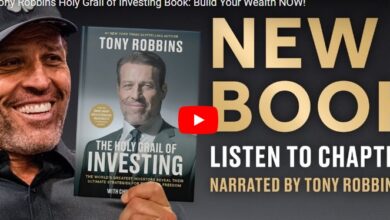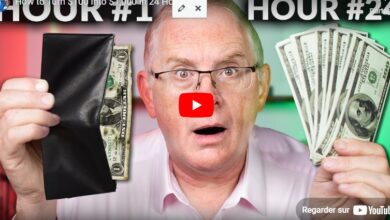The Wealth Stack: 7 Assets [REQUIRED] for Financial Freedom
If you’re taking the time to read my words, chances are good you are ready to earn more — to find ways to build the kind of long-term wealth that can change your life. Trust me when I say I know exactly how that feels.
I didn’t grow up with much, and I barely knew how money worked until I was in college and figuring out what to do with my life. Fortunately, a series of events led to me learning a ton about money in a relatively short amount of time. I also had the right mindset to build wealth, which is something I didn’t even realize. More on that in a minute.
Here’s the good news — the fact you’re still reading means you already have a leg up when it comes to growing wealth.
Most people think of life as something that happens to them instead of a reality they can largely control themselves. The fact you’re reading financial content means you’re ready to take the reins, so that’s an excellent place to start.
You can listen to this post on the Good Financial Cents podcast here:
Changing Your Mindset: Fixed vs. Growth
If you want to move forward, however, you’ll have to do a little more work from here. Why? Because you need to have a “mindset switch” that puts you in a position to think about money differently.
If you’re looking for some reading material that can help, I highly recommend the book Mindset: The New Psychology of Success by Carol S. Dweck.
Whether you read this book or not, you should take the time to learn the difference between a fixed mindset vs. a growth mindset.
A fixed mindset is something you may be dealing with right now. With this type of mindset, you actively avoid challenges at all costs, and you tend to blame other people for where you’re at. I often refer to this as a broke mindset because you’ll never gain wealth you allow yourself to stay stuck here.
With a growth mindset, on the other hand, you learn to enjoy challenges, and you relish in finding ways to overcome any obstacles that block your path.
Read that book or not, but you need a growth mindset to get where you want to be. Here’s some more advice that can help:
Stop looking in the rearview mirror.
Reflect on things that have happened in your life but don’t let them define who you are today.
One of my mentors, Dan Sullivan, says “Always make your future bigger than your past”, which embodies focusing on personal growth.
You won’t really move forward until you let go of all the negative feelings and fears that are holding you back. With that in mind, do whatever you have to do to change your mindset about building wealth. Trust me — it will be worth it!
I share in some personal insight on how I developed a growth mindset in my YouTube video here:
Okay, time to get stacking…
How to Build Your Wealth Stack
Once you’re in the right frame of mind, you can start building something I refer to as the “Wealth Stack” piece by piece. This stack is a framework for building the financial life you have always wanted, but it’s important to remember you should try not to skip ahead!
The Wealth Stack is built in a way that each piece lets you build the next, so skipping to the final phase rarely works out. If your goal is building wealth that can let you escape your 9 to 5 job, have more time to pursue your hobbies or just quit worrying about money, here’s exactly what I suggest you do.
Step 1: Get Your CYA Fund in Place
The first thing you should do is build up your CYA fund, which means “cover your ass” and not “see you later.”
Some people would refer to this fund as an emergency fund, which also works. It doesn’t really matter what you call it.
One important lesson I’ve learned over the years is the fact that life happens, and surprise bills will always pop up. Unfortunately, I really did learn this lesson the hard way. In fact, I didn’t even have a savings account until after I got married and was deployed to Iraq. I just had a checking account until then, and I would only find out how much money I had when I took cash out of an ATM.
As you can imagine, keeping a running account of my balance via ATM receipts was a recipe for disaster. I bounced a few checks and paid quite a bit in overdraft fees over the course of several years.
Twenty years and four kids later, I know for a fact that having an emergency fund brings an enormous amount of peace of mind and freedom. You need to have some cash reserves to cover whatever comes up in your life, whether you’re suddenly facing surprise car repairs, unexpected medical bills or something else.
But, how much do you need? I would suggest starting with $1,000 then building it up to $5,000 over whatever timeline it takes. Some experts suggest having three to six months of expenses set aside in an e-fund, and that’s great, but the point is to just get started with whatever you have.
Also, make sure you avoid the temptation to park your CYA fund in an investment that isn’t guaranteed to pay off. You want this money to be there if your kid breaks a leg or you suddenly lose your job, so park it in a high-yield savings account and, most importantly, leave it alone.
Step 2: Open a Roth IRA – Tax Free Lovin’
Opening a Roth IRA is another important step you should take early on, and there are several reasons why. First, opening this type of account early gives you more time for your investments to grow and compound. Second, learning to build wealth means your income could grow substantially, and the government stops letting you contribute to a Roth IRA if you earn too much. Ask me how I know!
I haven’t actually been able to actually contribute to my Roth IRA for a long time, which is a good problem to have. I just earn way too much money! However, my Roth money is still growing and working on my behalf. I think I contributed a total of $11,000 to my Roth IRA back in the day, and now that account is worth over $250,000. I recently revealed my Roth IRA portfolio and a big change I made in my portfolio in this video:
The Roth IRA is a crucial financial tool because this account lets you invest after-tax money that grows tax-free over time. More importantly, you can take distributions in retirement without paying income taxes. Basically, you pay taxes now and avoid taxes later on.
Opening a Roth IRA is also a lesson in itself because you actually have to do it yourself vs. just adding money via payroll to a workplace 401(k) account. This means you have to take steps to research which platform to use, then you have to choose the investments to go into your Roth IRA. You can invest into individual stocks, index funds, ETFs and more, but you have to make that choice.
You don’t even have to invest a lot to get started, and Roth IRA contribution limits aren’t even that high. In 2021, most people can contribute up to $6,000 to an IRA, while those ages 50 and older can contribute an additional $1,000 in catch-up contributions for a total of $7,000.
Either way, get this cash in your account now so it can grow and compound and work on your behalf. When you get to retirement, this is the best tax-free income source you can have.
Step 3: Start a Personal Equity Fund
This step could seem cheesy, but it’s absolutely crucial! The Personal Equity Fund is an important component of the Wealth Stack because it gives you the opportunity to learn and grow.
This account is predicated on the idea that you are your best investment. It sounds so cliche, but it’s absolutely true. If you’re able to improve yourself or learn new skills, building wealth suddenly becomes a lot easier.
You can open your Personal Equity Fund at a regular bank or wherever you want. The important part is getting some money in there.
How do you spend this cash on yourself? You can basically use it for anything you want to do that could help you learn and grow. An example might be attending a conference that could help you learn new skills or make it easier to connect with a mentor you have always wanted to meet.
You could also use this fund to:
- Buy a course that teaches you a new skill
- Hire a business coach to help you get an idea off the ground
- Buy self-improvement books you have always wanted to read
- Earn a certification that can help you increase your salary
- Join a paid Mastermind course
Basically, anything that can help you gain experience and knowledge you didn’t have before will work. When you put this money away, you are giving yourself permission to invest in yourself. And trust me, this type of investment will always pay off.
Step 4: Open an Investment Account
One of the best ways to learn about investing is through basic trial and error. You open an account and you play around with a few ideas you’ve had. All of a sudden, you’re learning what works and what doesn’t, and you’re building a core of knowledge you can continue growing over time.
I first learned how to invest by opening an account and buying my first investment, which was a mutual fund. I didn’t have a lot to invest at the time but started with only $25 per month.
When I first started learning about cryptocurrency, I boosted my knowledge by opening a Coinbase account and investing just $1,000 to start. That’s not life changing money, but that’s how I chose to dive in — head first.
This is also how I learned about other investment platforms. I started investing with Betterment after opening an account and throwing in some money, and the same is true with Fundrise and Lending Club.
The point is, you should open an investment account once you get to this part of your Wealth Stack. It can be with one of the platforms I mentioned already, but it could also be with platforms like Robinhood, Ally Invest or M1 Finance.
It doesn’t really matter as long as you’re opening an account and getting started. You’re also learning how to invest as you go, and hopefully reading as much as you can. Over time, you’ll learn what works and what doesn’t, as well as how your individual investing style and risk tolerance comes into play.
Step 5: Open a Self-Directed 401(k)
Have you ever heard about Robert Kiyosaki’s “cashflow quadrant” idea? The Rich Dad, Poor Dad author actually has a whole book about it: Rich Dad’s CASHFLOW Quadrant: Rich Dad’s Guide to Financial Freedom.
According to Kiyosaki, there are four basic quadrants that lead to wealth — being an employee, becoming self-employed, being a business owner and becoming an investor.
As you progress through each step, he says you are able to learn new skills and buy a new level of freedom for yourself. However, you can spend years getting to where you want to be, and that’s okay.
Either way, once you find a way to become self-employed or a business owner, you can unlock a new selection of retirement accounts that let you stash away more money on a tax-advantaged basis. If you use these accounts and max them out, you can grow wealth much faster and take advantage of tax benefits on the front-end, too.
For example, the basic 401(k) plan you get through your job only lets you contribute up to $19,500 in 2021. That’s a lot, but you can do a lot more if you’re self-employed.
For example, my first self-employment retirement account was a SEP IRA, although I eventually transitioned to a Solo 401(k). With a SEP IRA, you can contribute up to 25% of your compensation with a maximum of $58,000 in 2021.
With a Solo 401(k), on the other hand, you contribute as a business owner and as an employee. On the employee end, you can defer up to $19,500 of your salary in 2021. On the business owner end, you can contribute up to 25% of compensation as defined by your plan up to a maximum total limit of $58,000 in 2021.
Imagine how much more money you could have for retirement if you contributed $58,000 within a year instead of $19,500. Heck, any amount of money invested over the regular 401(k) contribution limit could improve your results, especially when you take compounding into account.
And just like the Roth IRA, your self-employment retirement account lets you choose the investments you want to include. For example, I have Tesla, Google, and Facebook stock in mine. However, you can also go the easy route and invest into index funds, mutual funds, or ETFs. It’s really up to you.
Step 6: Protect Your ASSets
This next topic is pretty boring, but it’s just as important as the rest. You need all kinds of insurance to protect your assets. If you fail to do so, you’re making yourself vulnerable to losing some of the wealth you’ve created.
In this step, I’m talking about making sure you have enough health insurance, car insurance, and homeowners or renter’s insurance. Another important component is life insurance, which can be very inexpensive to buy if you go with a basic term policy.
Also look into an umbrella insurance policy, which is a type of coverage that can kick in with more protection if your other insurance policies are tapped out. If you have car insurance and you get in an awful wreck that’s your fault, for example, you could exhaust your policy limits in a hurry. From there, the other person in the wreck has the right to sue you for more money. That’s where an umbrella insurance policy comes in.
Fortunately, umbrella insurance is crazy cheap! You may be able to get $1 million in coverage for a few hundred bucks per year, or even higher policy limits for slightly more than that.
If you have taken the time to build wealth, you need to make sure you protect your assets. Insurance coverage lets you do just that, but only if you buy the coverage you need before you need it.
Step 7: Create a Self-Managed Income Producing Asset
This final step is basically the Holy Grail of the Wealth Stack. I’m talking about creating an income producing asset you can basically live on for the rest of your life.
Sometimes income producing assets are passive, and other times they’re not. In my case, I have built several income producing assets that took a lot of grunt work to get off the ground. However, they became more passive over time, which has been my goal all along.
An example of a self-managed income producing asset could be:
- A portfolio of rental properties that provide monthly income
- A portfolio of dividend stocks
- A product you created that you can sell over and over again
- A business, either brick and mortar or online
Currently, my self-managed income producing asset is my own website — Good Financial Cents. Before that, it was my financial planning practice, which I sold several years ago.
Keep in mind that neither one of these businesses were passive for me for a long time, which is how it usually works. With my financial planning practice, I worked my tail off for a decade before I was able to work less and enjoy life more, then eventually sell it altogether.
The same is true with my blog, which I started in 2008. It wasn’t until 2015 that it started making a substantial amount of money, and that’s when I decided I could sell my financial practice to focus on blogging full-time.
I still take my website seriously, but it’s a lot more passive than it used to be. My blog has gotten to that point because I have a team of people working with me and helping me achieve my goals.
Because I outsource many of the tasks required to keep my online business afloat, I can travel when I want and I never have to worry about who covers my shift or whether I have income coming in.
When you are able to build a business that earns money when you sleep, that’s when you finally call all the shots in your life. You’re still working hard and striving to be the best you can be, but it’s all on your own terms now.
What Should You Do Now?
All the steps of the Wealth Stack are important, but for different reasons. Some steps put you in a position to build wealth while others force you to learn important lessons you can’t get without doing something yourself. Many of us are wired to look for shortcuts, but you have to go through all of it to get where you want to be.
So, what should you do now? For the most part, you should see where you are in the Wealth Stack and go from there. If you’re still on step one, that’s perfectly okay. We all have to start somewhere — even if that somewhere is the very beginning. .
Whatever you do, don’t put off building wealth for another week or even another day. Your empire won’t build itself, and the life you really want is waiting for you.






